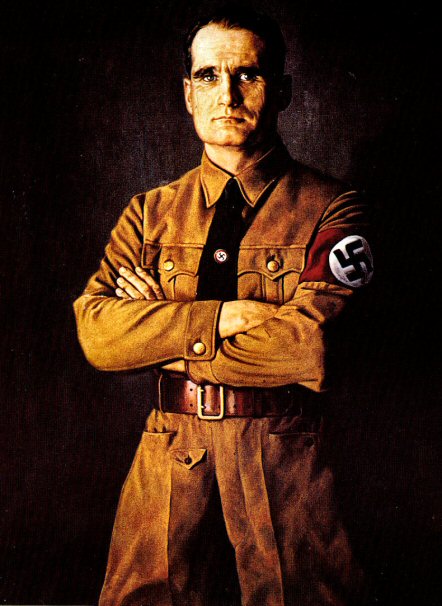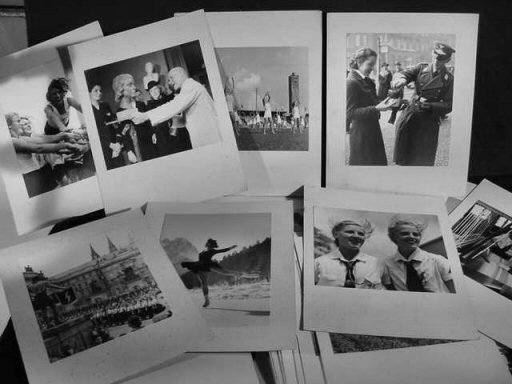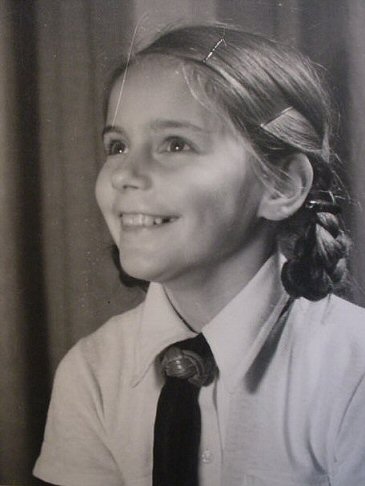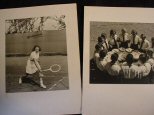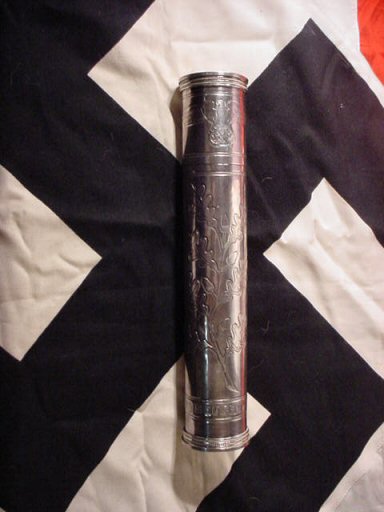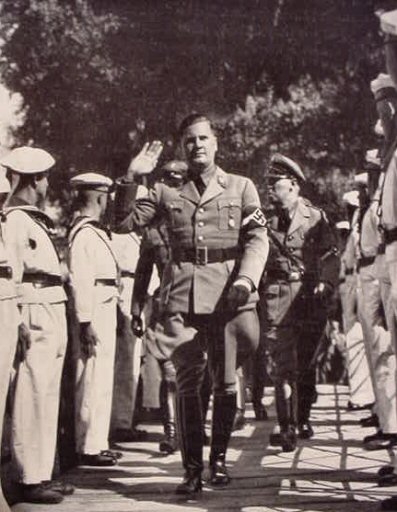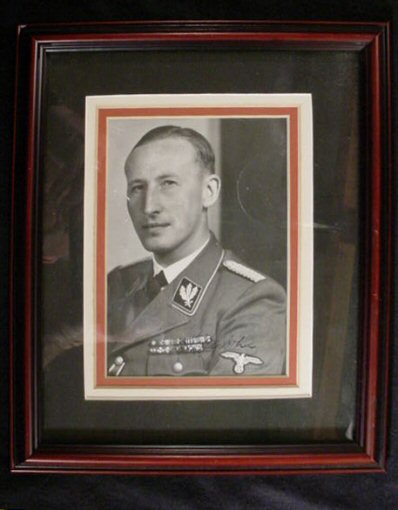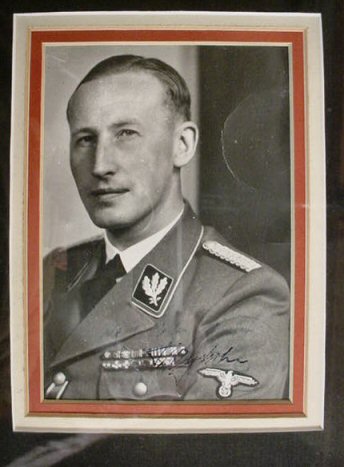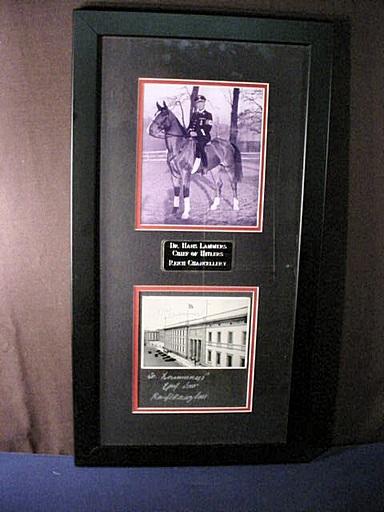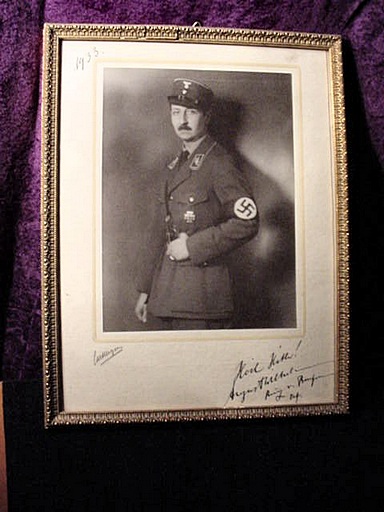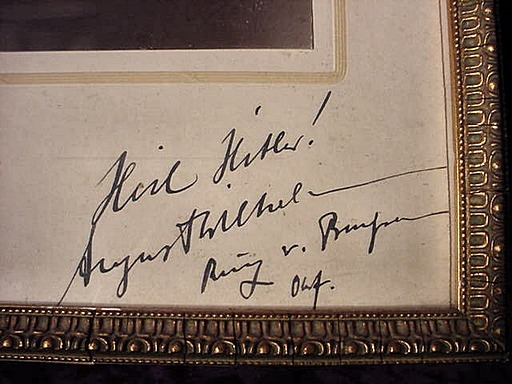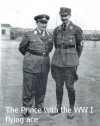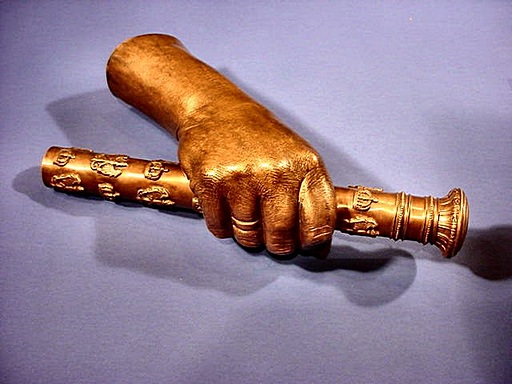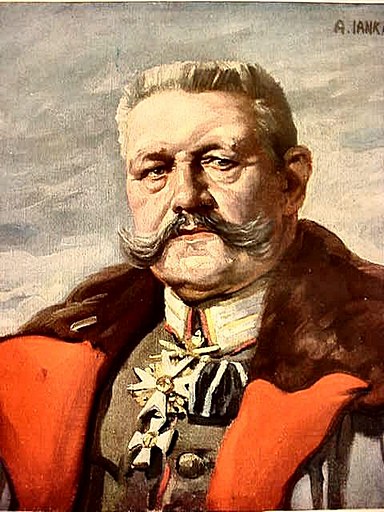|
|
|
|
Personality Items
Page 3
|
|
|
|||||||||||||||||||||||||||||||||||
|
Grouping of Mounted Pictures from Dr. Arthur Seyss-Inquart (Item PERS 3-1; ART 10-12; YOUTH 5-6) |
|||||||||||||||||||||||||||||||||||
| DESCRIPTION: Here is an astounding collection from the personal collection of Dr. Arthur Seyss-Inquart. He was a prominent National Socialist official in Austria. He was born in Stannern Moravia, then part of Austria-Hungary. He studied law at the University of Vienna and served valiantly in WWI and was decorated for bravery on a number of occasions. He went into law practice in 1921, joined with the Chancellorship of Dollfuss in 1933, later was appointed Minister of the Interior by Kurt Schuschnigg, when the German Führer announced intentions of marching into Austria. Schuschnigg suddenly resigned as chancellor and Seyss-Inquart was appointed Chancellor of Austria. He was more than happy to greet the German troops as they gloriously crossed the border after the Anschluss. He, like millions of Austrians, gloried in the union once more of Germany with what was the Ostmark (eastern territory of the once-proud Germanic Reich). It was he who signed the legislative act of reuniting Austria with the Reich. He received the honorary rank of SS-Gruppenführer from Reichsführer Himmler and in May 1939, he was made minister without portfolio in the NS government. Later in 1939, he was made administrative chief for southern Poland, but did not take up that position before the general government was created and then he became a deputy to the Reich’s Governor Hans Frank. Following the capitulation of the low countries, he was appointed Reichskommissar for the liberated Netherlands, and was charged with the civil administration, with creating close economic cooperation with Germany, and with defending the interests of the Reich. The actual administration of the Netherlands was largely controlled by Seyss-Inquart, himself. He oversaw the politicization of cultural groups right down to the Chess Players’ Club through the Kulturkammer, and set up a number of politicized associations. He never tired of indulging in efforts to better the community doings and lent much support to the Hitler Youth and girls’ NS groups. He introduced measures to combat terror and revolution from the left by imposing huge fines on groups and individuals who tried to bring down the legal government, he executed murderers and some potential murderers (reds). He took measures to remove Jews from the government, the media, and leading positions in the economy. When the allies advanced into the Netherlands the NS regime attempted to enact a scorched-earth policy, and some docks and harbors were destroyed. Seyss-Inquart, however, greatly limited these actions, which would have destroyed much of the Netherlands. He remained Reichskommissar until May 8, 1945, when, after a meeting with Grand Admiral Dönitz to confirm his blocking of the scorched-earth orders, he surrendered to the Americans in Hamburg. At the Nuremberg trials he was found guilty of a whole shopping basket of the “star chamber” crimes similar to what the U.S. Government indulges in now, like planning aggressive war, crimes against peace, crimes against humanity, etc. He was sentenced to hang. His last words were: “I hope that this execution is the last act of the tragedy of the Second World War and that the lesson taken from this world war will be that peace and understanding should exist between peoples. I believe in Germany.” The pictures are almost a memorial to this energetic and resourceful man. They reflect his interest in the youth of Holland and the remarkable culture that they so markedly mastered at that pivotal point in history. The pictures are all mounted on 9 x 12-inch very heavy stock cardboard. Most of the pictures are 6 1/4 x 8 inches. There are also some 9 x6-inch pictures. There are 59 pictures altogether. Of all of the young girls’ organizations and BDM (Bund Deutscher Madel), two pictures have Dr. Seyss-Inquart in them. There are pictures of the girls and maidens working at various crafts, indulging in various sports activities, playing at music, enjoying theater, collecting donations for the WhW, learning cooking, participating in ceremonies, hiking, studying the arts, tilling the soil, reading poetry, sharing lots of fellowship, engaging in acrobatics, painting, and involvement in health care, performing aerobics and ballet, etc. It is not known if this group of pictures is all, if any, from the Netherlands or if Dr. Seyss-Inquart had them for training and indoctrination purposes, but on the back of each picture card is the stamp identifying them as his property. The stamp reads: “Dr. Arthur Seyss-Inquart Den Haag.” This may be one of the most important groups of archival photos ever offered on line and Germania once more is proud to offer it to the genuine collector of fine memorabilia.
PRICE: SOLD |
|
|||||||||||||||||||||||||||||||||||||||||||||||||||
|
Special! Baldur von Schirach Reich Youth Leader Presentation Scroll. Fantastic! (Item PERS 3-2; YOUTH 7-1) |
|||||||||||||||||||||||||||||||||||||||||||||||||||
| DESCRIPTION: Here is a presentation gift to none other than the head of the entire Hitler Youth organization Reichsjugendführer Baldur von Schirach. It was presented by the Rhein and Ruhr Niederrhain district of the Hitler Youth and signed by Heinz Deinalt, the district führer and presented at the city of Düsseldorf on the 30th of October 1936. It was presented to v. Schirach on the fifth anniversary of his commission as Reich’s youth leader. On October 30, 1931, Adolf Hitler appointed 24-year-old Baldur v. Schirach to the new position of Reichsjugendführer dealing with all youth matters. The scroll is beautiful. It is on genuine parchment paper that measures a large 32 x 11 1/2 inches in size. It’s rolled and contained in a silver cylinder that is highly engraved with presentation words and a great youth-leader-style eagle that clutches both the cogged wheel and swastika and the youth diamond. There is an oak-leaf motif that is the central motif and design. The cylinder is marked with the ‘925’ silver designation and the entire piece is crafted in silver of the highest grade of the precious metal used in German jewelry and object d’art. The cylinder has an engraved section that proclaims: “Die Gebietsschule abtl. Handwerk Duisburg-Hamborn.” (This is translated as the “Area School ‘Section Handwork’ in the hamlets of Duisburg and Hamborn.” On the area just above the bottom cap it says in engraving: “Die Jugend von Ruhr und Rhein,” “The Youth of the Ruhr-Rhein river regions,” and at the top “30 Oktober 1936.” On the back of the cap is that date corresponding exactly with the date in 1931 when Schirach was appointed and on the front of this opening cap is the magnificent eagle previously mentioned and the maker mark and silver designation. The eagle, except for the double insignia, is typical of a government official-style that v. Schirach would wear being Reichsleiter rank. The capped ends have hammered multicircle design. The scroll is hand done in the height of calligraphy at its finest. The is one of the most important pieces of Third Reich history that we have ever offered at Germania and of course those (“other web sites”) couldn’t hope to match it. V. Schirach was one of the important pivotal individuals of the Third Reich next to Hitler, Himmler, and Göring. The young man formed the youth of the future: Their strength, their morals, their artistic endeavors, their agenda, that, unfortunately, was smashed upon the rocks in 1945 and its like will never be seen again as youth marches today to the sounds of different drummers: A.C.D.C., Kiss, Grateful Dead, and they look up to idols like Paris Hilton, Prince, Oprah Winfrey, Michael Jackson, etc. Oswald Spengler was unfortunately right! Baldur v. Schirach was for a few short years the leader of the youth that would have formed the “Aryan Imperium” of tomorrow. The von Schirachs were an aristocratic family (ennobled by the Empress Maria Theresa in 1776, hence von Schirach), which had strong connections with the United States. Baldur's paternal great-grandfather emigrated to America in 1855, and his son, Friedrich Karl, served as a major in the Union Army during the Civil War, subsequently marrying into one of America's patrician families. In 1871, he returned to Germany with his American wife, where Baldur's father, Karl Baily Norris von Schirach, was born. Von Schirach père remained in Germany, pursuing the career of an army officer, but reinforced the United States family connection by marrying an American girl, a Miss Emma Middleton Tillou of Philadelphia, in 1896. Baldur, the offspring of this union, was born on March 9, 1907. The following year his father resigned his commission to become director of the theater at Weimar. Brought up the pampered child of well-to-do parents with artistic leanings, young Baldur was dispatched to Munich University to study art history and German folklore. In Munich, the epicenter of the Nazi movement, Baldur became a member of the inner circle of its leadership, through his friendship with Hitler's personal photographer, Heinrich Hoffmann, whose daughter he later married. He enrolled in the NSDAP on May 9, 1925, (Party number 17,251) and at the same time, he joined the ranks of the SA (among the burly stalwarts of the Storm Troops. At 24, von Schirach now occupied what was soon to prove one of the key posts in the Nazi hierarchy. Numerous incompetent HJ bosses were dismissed or downgraded, their places being taken in the main by former NSS and NSDSt.B leaders. The class composition of the HJ had been radically altered by the time von Renteln resigned in June 1932. Von Schirach now assumed personal control of both the HJ and the NSS (which the latter was shortly thereafter obliged to merge with the HJ). Thus in July 1932, von Schirach had become the indisputable supreme leader of the NSDAP's youth, and within a year all of Germany's youth. The Weimar Republic was visibly tottering. In its justifiable alarm at the escalation of street violence, the authorities tried to ban all political militias. Hitler foresaw this possibility, and, fearing that the HJ might be banned along with its SA "parent," decided to sever the formal link between the two. On May 13, 1932, he issued a decree which released the HJ from its subordination to the Chief of Staff of the SA. Von Schirach was elevated to the status of a Department Head (Amtsleiter) at NSDAP headquarters answerable only to Hitler. The Hitler Youths' independence was now absolute. The decree came too late; however, to save the HJ from the ban which was nationwide and in force from April 13th until it was repealed on June 17th. In the General Election of July 31, 1932, the NSDAP won 230 seats in the Reichstag, making it the largest single party, although without an overall majority. Among the new Reichstag deputies was Baldur von Schirach. By way of celebrating his success, von Schirach arranged for a National Youth Day to be held at Potsdam that October. The RJF anticipated a possible turnout of around 20,000. The reality surpassed his wildest expectations. Some 100,000 young persons (15,000 of them girls) took part in a giant rally on October 1st/2nd. It was a triumph for Hitler and von Schirach. Only 3 years previously the HJ contingent at Nürnberg had numbered a mere 2,000. A second general election was held on November 6, 1932. In it the Nazis lost some of the ground they had won in July but still remained the largest single party in the Reichstag. After a series of backstairs deals and intrigues, which need not concern us here, President Hindenburg appointed Hitler Chancellor (Prime Minister) of Germany on January 30, 1933. The youth sections of the outlawed political parties vanished, of course. Hitler would not tolerate any other youth group in Germany. On June 17, 1933, a significant alteration was announced to the Reichsjugendführer title that v. Schirach bore. He became Jugendführer des Deutschen Reichs (Youth leader of the German Reich). Now all German youth came within the sphere of his authority. Much abut the Hitler Youth and its leader can be found on the internet (go “Googling”!) Most of the material is despoiled by the writers who stand firmly on the left or meekly on the capitalistic neo-con right. Perhaps a glint of truth or at least rather unbiased truth might leak out if one can stand to wade through the fragrant garbage. As we have said before: “History is written by the winners of a war and they write the history of the losers as well!” This piece of prestigious, vastly important history is offered as a real Andenken memorabilia of an effort to create a youth as Hitler put it: “In my view, German youth must be slim and trim; as swift as a greyhound, tough as leather, and as hard as Krupp’s steel!” The following is the translation of the parchment scroll: As a token for your help in connection with the schooling and training of our youth groups composed of creative National Socialist youth, our district extends to you now (presents) the district schools and divisional guilds in district Duisburg-Hamborn. The youth membership have produced (this esteemed work) as a gift to you. It is from the youth of the Ruhr-Niederrhein on the fifth anniversary of your appointment (as national youth leader) You, alone, determined our path! Another key to the gates of leadership will never be found because “achievement through work” is the only key. Whomsoever’s hand holds this key, whether it be a laborer’s son, a builder’s son, or the son of an academically learned man, it matters not. Only one thing is important; he must be reborn into the nobility of work and of this particular nobility, our “new youth” are very well acquainted. From this charge we will therefore build up our noble handworker’s schooling. This gift shall be but an expression of our strong and deterimed will to march skillfully in the path where you have led us. “Heil Hitler!” The city Düsseldorf 30 Oct 1936. Heinz Deinalt PRICE: NO LONGER AVAILABLE. |
|
||||||
|
||||||
| DESCRIPTION: This is what many of our customers have anxiously waited for: a signed photo of none other than Reinhard Tristan Eugen Heydrich, Chief for the Reich Security main office (including the SD), the Gestapo and Kripo, NS police agencies, and Reich Governor of Bohemia and Moravia. Adolf Hitler always considered this austere, accomplished tactician as possible successor. His first middle name, Tristan, stems from Richard Wagner's Tristan and Isolde. His other middle named, Eugen, probably derives from a military hero Prinz Eugen of Savoy. The German cruiser, Prinz Eugen, was also named for Eugene of Savoy as was the 7th Waffen-SS Division. So, on the 7th of March 1904, Reinhard Heydrich came into the world and was given the names of heroes of the Germanic past. Certain historic revisionists who believe that this Obergruppenführer was truly one of these heroes. That must be agreed or disagreed by the reader, but certain books of late seem to differ greatly about this man and his mission, plus the plot to murder him, hatched by Churchill and the British General staff, is being looked at in a different light today. We will take no position except to say that he was a remarkable individual, indeed. The picture measures about 4 1/2 by 6 1/2 inches and is nicely framed and matted with a black, white, and red German national colors. The white and red are from the original Third Reich matting. The frame measures 9.5 x 11.5 inches. On close inspection there appears to be some message other than the signature, but it is not discernible. It might be a dedication to whomever he was presenting the picture. There is also the faint “ghost” of an official stamp at shoulder level, and he signed his name through this. There is some evidence of the early mounting that was not professional, and some glue shows at the left-top edge, but when viewed straight on, this does not detract. There is also a c-shaped bulge and obvious scratches at about one o'clock in the black background. Other than that and a tiny bulge or two, the picture is quite presentable. It was found after being hidden in Germany for years and being shifted from place to place it suffered a bit, but it is one of the rarest signatures and most desirable in the world. It is not cheap, but it is 100 times more rare than a 1933-model SS officer’s chained dagger. After all, it is entirely unique and totally irreplaceable. We show a Heydrich signature from Charles Hamilton's book, Second Volume, Leaders and Personalities of the Third Reich, for comparison.
PRICE: $3,500.00 Special sale: the consigner has reduced the price to $2,850.00 |
|
||||||
|
||||||
| DESCRIPTION: This is the ultra-rare signature of Dr. Hans Lammers, one of Hitler's closest friends and the honorary SS man that the Führer chose to be the head of his new Reich Chancellery. He was born in 1879 and died in 1962. Lammers was a clever lawyer who specialized in interpreting legal tangles for the NS party. From 1933 to 1945 he served as state secretary and eventually as minister and head of the chancellery. He was an able administrator and you can see his signature on many state documents. He was also a fine horseman and enjoyed riding at every possible break in government affairs. This human dynamo was old, but not decrepit by any means. He was always dependable and efficient in his work. He fell victim to the Nuremberg Star Chamber Court in 1945. He was sentenced on dubious and mostly false charges and sentenced to 20 years in prison and released from Landsburg on December 15, 1951. He died at Dusseldorf on January 4, 1962. The framed picture of the new Reichs Chancellery has his hand signature. It is nicely framed with museum-treatment matting (acid-free) and nonglare glass. A great picture that is a view of him on horseback is included. The frame measures 24 x 13 inches. The signed picture is 6 x 6 inches, while the equestrian picture measures 6 x 7 inches. This is a great presentation, dramatic and neat. It will look great in any NS collection.
PRICE: $750.00 |
|
||||||||||
|
Signed Photograph of August Wilhelm, Prince of Prussia (Item PERS 3-5; SA 12-3) |
||||||||||
| DESCRIPTION: August Wilhelm, 1887-1949, was the fourth son of Kaiser Wilhelm II. He was born at the Hohenzollern Palace at Potsdam on January 29, 1887. He was called Auwi. His mother was the Kaiser's first wife, Augusta Victoria of Schleswig-Holstein. He fought valiantly in World War I, and after the war joined the anti-Bolshevik conservative veteran group known as the “Stalhelm” (steel helmet). Against his father's will, he joined the revolutionary National Socialist German Workers Party (NSDAP) led by Adolf Hitler, and in 1933 he became a member of the SA and was also a member of the Reichstag. In 1939 he was promoted to the rank of SA-Obergruppenführer. He actually held many administrative posts in Prussia before joining the Nazi Party. In 1929, as a new member, he toured Germany lecturing on behalf of Hitler. He was very popular among the German citizenry and thus very beneficial to the plans and agenda of the party. In 1931 there was a police raid of one of the NS meetings in Königsberg and Prince Auwi was badly beaten, but he still kept up his association and membership with the NS party, especially the SA, which he proudly served. All during the Kampfzeit, the prince rose swiftly in the ranks of the storm troops and finally became a full general in 1943. He was always loyal and always stood in awe of the Führer and remained a dedicated NS stalwart throughout the war. In 1945 he was sentenced to three years’ imprisonment. For what? Only because he was a patriot for his Fatherland and the son of Kaiser Wilhelm, and a faithful follower of Adolf Hitler. He committed no war crimes. His imprisonment only served the interests of those who wanted to break the will and spirit of the German people. And of course in Germany today, “the beat goes on.” The framed picture is dated 1933 in the upper left corner and is signed by the Prince with “Heil Hitler” emphatically written in his hand. Underneath his name there is another short inscription that we can't make out. The photo is also signed by the photographer (illegible). The actual picture measures 9 1/4 by 6 1/2 inches. The entire original frame measures 13 1/2 x 10 1/2 inches. The prince is posed in SA uniform with collar tabs that look to be denoting the rank of possibly Oberführer or Brigadeführer. The picture is in perfect condition, showing no creases or fading. Here's a chance to purchase a great piece with superb historical significance that spans two German Reichs memorializes a patriotic royal personage who stood defiant in his beliefs.
PRICE: $1,960.00 |
|
||||||||||||||||||||||||||||||||||
|
Hindenburg’s “Hand of Friendship and Vindication” in Bronze |
||||||||||||||||||||||||||||||||||
| DESCRIPTION: This is one of the most historically important relics we have ever offered on Germania’s site. It’s practically unique and as far as we know only a handful have ever been made and we know of only two in existence or on display (ours is one of them). The depiction is the right hand of Paul von Hindenburg, the WWI German Army Chief of the General Staff and Grand Marshal of the Reich. We have reason to believe that this one was presented to Dr. Otto Meissner, 1880-1953, who was State Secretary serving under Hindenburg when later the aged marshal was appointed as the postwar Reich’s president. Meissner was in this capacity from 1924 to 1945. He was a personal close friend of Hindenburg even back in the days of the Great War. When Adolf Hitler came to power he gave him the title of Reich Minister of the Greater German Reich and kept him doing the work he was so proficient at doing. Meissner was always the bureaucrat’s bureaucrat. Now to this remarkable sculpture. There is a fascinating story connected to it and it is written up in a beautiful book out of Germany entitled “Mythos Marshallstab” der Marschallstab in der Preussischen un Deutschen Geschichte von 1852 bis 1945. This is a 360-page book (now practically unavailable) that gives the history of the marshal’s batons of Prussia and Germany from 1852 to the end of World War Two. The book is incredible with beautiful pictures of the batons and their owners through the many years. On pages 124 and 125 there is a picture of the style of baton that we now present. The legend goes…the German Kaiser of Prussia and Emperor of Germany had summarily declared in January 1915 that four new army groups were to be earmarked to be deployed on the eastern front against the recommendation of an officer, Erich von Falkenhayn, 1861-1922, who was then chief of the general staff. Hindenburg therefore sent Major von Haeften to Berlin to pass the word to the empress Augusta Victoria that the constant disagreements with Falkenhayn were becoming unbearable. The empress, after hearing this report, wrote a letter to the emperor asking him to intervene to stop Falkenhayn’s meddling in the ability of Hindenburg to run the war in the east. The emperor’s remark about the letter from the empress thereupon was: “That’s all we need now, women meddling into this affair.” When Major von Haeften suggested the transfer of at least a few divisions from the western front to stem the Russian attack in the Masurian Lakes area the Kaiser was livid and angry and he had v. Haeften transferred to a penal unit. This is seen in a letter of March 1977 from Dr. Anton Ritthaler from the archives of the house of the kings of Prussia (Hohenzollern Castle). Then it came to pass that the empress Victoria to heal the rift that resulted from all of this between Kaiser Wilhelm II and Field Marshal Hindenburg ordered the Königsberg teacher in the Academy of Fine Arts professor Stanislaus Cauer, to create two bronze, sculpted hands holding a depiction of Hindenburg’s marshal’s baton that he had been awarded in 1914 after the victory at Tannenberg. Both of these original bronzes are mounted on a marble slab with a brass plate and inscribed: “It is the wish of Her Majesty Empress Auguste Victoria that this hand be a sign of renewed friendship between his majesty Wilhelm II and his great Field Marshal von Hindenburg.” At the end of the sculpture is an inscription that reads the date and Lützen May 15, 1915 St. Cauer.” One of the castings was presented to Kaiser Wilhelm II, while the other was presented to Hindenburg. The original template cast, however, stayed with Prof. Cauer. In the 1930s some more bronzes were produced using the same die or template cast. One was given personally by v. Hindenburg to State Secretary Meissner in 1930 on his 50th birthday. Other recipients were the family of Brockhausen, relatives of v. Hindenburg and one to Prof. Dr. Sauerbruch*, and one to Ludendorff. The name Lützen in the inscription refers to a town in the former kingdom of Prussia. This was the place where the famed Teutonic knights built a mighty castle and fortress in 1340 located at the isthmus between the two Masurian Lakes. We think it highly interesting that this was the place of presentation of the sculpture to v. Hindenburg as it was also the place where the disagreement was born!!! All in all, this is a very fascinating relic of war, majesty, honor, and nobility; a tribute to the grand Kaiser and marshal and to the seemingly clever yet kindly act of a sovereign empress. The sculpture measurements are with the hand and arm 9 inches. The baton is 12 inches long. The thickness of the wrist portion is about 2 1/2 x 3 inches; a semidiameter. The baton is decorated with depictions of the Prussian eagle and the Hohenzollern crown. They say that the hardest thing for an artist to present faithfully is a hand. Well, Prof. Cauer must have surely been one of the greatest of bronze sculptors as this hand is as near perfect as can be done (our opinion). The inscription on the end says: “Hand d. G.F.M. von Hindenburg Lötzen 1915.” The initials are for “die General Field Marshal von Hindenburg” and of course as previously mentioned Lötzen was the town where the presentation took place. Many of his works can be found in state collections, public memorials in Halle, Königsberg and Kreuznach. The buyer of this great historical treasure will be most fortunate as this is history personified! This is a great and of course prodigiously rare item of glorious Teutonic history. Just imagine this one on your office desk! It really should be in a museum, but we know you will provide a good home for it until the day comes when it will repose in a German museum collection. The story is fascinating and the piece is dramatically important. *Dr. Ferdinand Sauerbruch was the Reich president’s personal physician and the country’s leading surgeon. He was also Adolf Hitler’s personal physician, as well. The doctor was also a physician in attendance with other doctors when SS-Gruppenführer Reinhard Heydrich was operated on unsuccessfully and Germany lost the man who might well have won the war for the Fatherland and for Europe. PRICE: SOLD |
Page Three |
Page Six A Very Special Entry! One of the greatest historical treasures we have ever had the pleasure of offering. You have to see this one! CLICK HERE! |
Please refer to item designator in parentheses in all correspondence.
Please E-mail for any additional information you may need.If you prefer, contact 'Germania' at PO Box 68, Lakemont, GA 30552
or call at 706.782.1668 or 706.782.4398.
Please! do not call during the wee hours of the morning. The best time for calling us is between 10 and 11 am and between 9 and 11 pm eastern time.


